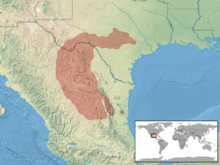Texas alligator lizard
| Texas alligator lizard | |
|---|---|
 | |
| Texas Alligator Lizard, Gerrhonotus infernalis | |
| Scientific classification | |
| Kingdom: | Animalia |
| Phylum: | Chordata |
| Subphylum: | Vertebrata |
| Class: | Reptilia |
| Order: | Squamata |
| Suborder: | Sauria |
| Family: | Anguidae |
| Subfamily: | Gerrhonotinae |
| Genus: | Gerrhonotus |
| Species: | G. infernalis |
| Binomial name | |
| Gerrhonotus infernalis Baird, 1859 | |
 | |
| Synonyms | |
The Texas alligator lizard (Gerrhonotus infernalis) is a species of lizard in the subfamily Gerrhonotinae found in the central region of the American state of Texas, and south into Mexico.
Description
The Texas alligator lizard is a medium-sized lizard, attaining a maximum total length (including tail) around 24 to 25 in (61 to 64 cm). It is the largest lizard species in Texas, and one of the largest alligator lizards in the world. These lizards have flat, wedge-shaped heads. They are generally a yellow-brown color, often with darker brown and white checker patterning on their dorsal surfaces, and uniformly light-colored, white, or grey on their ventral surfaces. Their scales are very stiff and plate-like. They have short limbs, and a tail that can fall off to distract a potential predator, but will regrow in time.
Behavior
Texas alligator lizards are relatively slow, diurnal lizards, with quite good vision. Though not generally aggressive, they may bite if handled, and are incorrectly considered to be venomous by many cultures.
Habitat
They are often found on rocky hillsides, where they hide among the stones or in limestone crevices.
Diet
Their primary diet is insects and other invertebrates, but they may sometimes prey on nestling birds or rodents.
Reproduction
Breeding occurs year-round; sometimes, multiple clutches of eggs are laid per year. Females will often stay near the nesting site to protect it, but no parental care occurs once the young alligator lizards hatch. The young generally have more striking markings, and are only about 3–4 in (7.6–10.2 cm) long (including tail).
References
- ↑ Hammerson GA, Vazquez Díaz J, Gadsden H, Quintero Díaz GE, Ponce-Campos P, Lavin P (2007). "Gerrhonotus infernalis". IUCN Red List of Threatened Species. Version 2008. International Union for Conservation of Nature. Retrieved 6 November 2008.
- ↑ The Reptile Database. www.reptile-database.org.
Further reading
- Baird SF. 1859. Description of New Genera and Species of North American Lizards in the Museum of the Smithsonian Institution. Proc. Acad. Nat. Sci. Philadelphia 10: 253-256. (Gerrhonotus infernalis, new species, p. 255).
- Behler JL, King FW. 1979. The Audubon Society Field Guide to North American Reptiles and Amphibians. New York: Alfred A. Knopf. 743 pp. ISBN 0-394-50824-6. (Gerrhonotus liocephalus infernalis, p. 541).
- Conant R. 1975. A Field Guide to Reptiles and Amphibians of Eastern and Central North America, Second Edition. Boston: Houghton Mifflin. xviii + 429 pp. + Plates 1-48. ISBN 0-395-19979-4 (hardcover), ISBN 0-395-19977-8 (paperback). (Gerrhonotus liocephalus infernalis, p. 134 + Plate 13 + Map 94).
- Smith HM, Brodie ED Jr. 1982. Reptiles of North America: A Guide to Field Identification. New York: Golden Press. 240 pp. ISBN 0-307-13666-3. (Gerrhonotus liocephalus infernalis, pp. 88–89).
- Zim HS, Smith HM. 1956. Reptiles and Amphibians: A Guide to Familiar Species: A Golden Nature Guide. Revised edition. New York: Simon and Schuster. 160 pp. (Gerrhonotus liocephalus [infernalis], pp. 66, 155).
